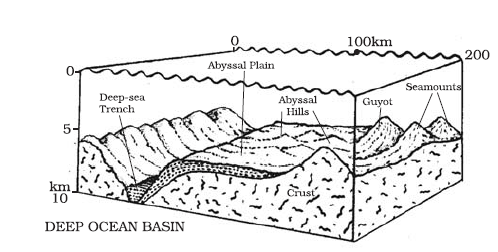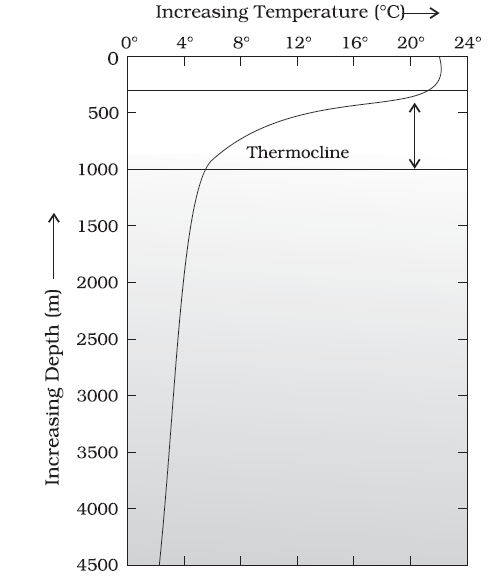Class 11 Geography NCERT Solutions Chapter 13 Water (Oceans)
1. Multiple choice questions.
(i) Identify the element which is not a part of the hydrological cycle
(a) Evaporation
(b) Hydration
(c) Precipitation
(d) Condensation
Answer: (b) Hydration
Explanation: Hydration is not a part of the hydrological cycle. The hydrological cycle, also known as the water cycle, involves processes such as evaporation, condensation, and precipitation, where water is continuously cycled between the Earth’s surface, atmosphere, and back. Hydration refers to the process of adding water molecules to a substance, typically involving the formation of a hydrate compound. It is not a primary process in the hydrological cycle.
(ii) The average depth of continental slope varies between
(a) 2-20m
(b) 200-2,000m
(c) 20-200m
(d) 2,000-20,000m
Answer: (b) 200-2000m
Explanation: The average depth of the continental slope typically varies between 200-2,000 meters.

(iii) Which one of the following is not a minor relief feature in the oceans:
(a) Seamount
(b) Atoll
(c) Oceanic Deep
(d) Guyot
Answer: (c) Oceanic Deep
Explanation: Oceanic Deep is not a minor relief feature in the oceans. It refers to the deep ocean floor areas, including trenches, rather than a specific minor relief feature.

(iv) Salinity is expressed as the amount of salt in grams dissolved in sea water per:
(a) 10 gm
(b) 1,000 gm
(c) 100 gm
(d) 10,000 gm
Answer: (b) 1000 gm
Explanation: Salinity is typically expressed as the amount of salt in grams dissolved in sea water per 1,000 grams (1 kilogram) of sea water.
(v) Which one of the following is the smallest ocean:
(a) Indian Ocean
(b) Arctic Ocean
(c) Atlantic Ocean
(d) Pacific Ocean
Answer: (b) Arctic Ocean
Explanation: The Arctic Ocean is the smallest of the world’s oceans.

2. Answer the following questions in about 30 words.
(i) Why do we call the earth a Blue Planet?
Ans: The Earth is called a Blue Planet due to its vast water bodies, primarily the oceans, which cover about 71% of its surface. The reflection and scattering of sunlight by water molecules give the planet a blue appearance when viewed from space.

(ii) What is a continental margin?
Ans: A continental margin refers to the zone where a continent’s edge meets the ocean. It includes the continental shelf, continental slope, and continental rise. This region is characterized by varying underwater landforms and geological features.

(iii) List out the deepest trenches of various oceans.
Ans: Some of the deepest ocean trenches include the Mariana Trench (Pacific Ocean), Tonga Trench (Pacific Ocean), Puerto Rico Trench (Atlantic Ocean), Sunda Trench (Indian Ocean), and South Sandwich Trench (Southern Ocean).
(iv) What is a thermocline?
Ans: A thermocline is a layer in the ocean where there is a rapid change in temperature with depth. It separates the warm upper layer (epipelagic zone) from the colder deeper layers and plays a crucial role in ocean circulation and vertical mixing.

(v) When you move into the ocean what thermal layers would you encounter? Why does the temperature vary with depth?
Ans: The temperature profile of oceans across middle and low latitudes can be conceptualized as a three-tiered structure extending from the ocean’s surface to its depths.
The uppermost layer constitutes the warm surface waters, approximately 500 meters thick, with temperatures spanning from 20°C to 25°C. While this tropical layer persists throughout the year, it forms only during summer in mid-latitudes.
Beneath lies the second layer, referred to as the thermocline, characterized by a rapid temperature drop as depth increases. The thermocline’s thickness ranges from 500 to 1,000 meters.
The third stratum, extending to the ocean’s profound depths, is significantly colder. Within the Arctic and Antarctic circles, surface water temperatures approach 0°C, leading to minimal temperature fluctuations as depth increases.
(vi) What is the salinity of sea water?
Salinity refers to the concentration of dissolved salts (primarily sodium chloride) in sea water. It is typically expressed in parts per thousand (ppt) and plays a significant role in ocean density, circulation, and marine ecosystems.
3. Answer the following questions in about 150 words.
(i) How are various elements of the hydrological cycle interrelated?
Ans: The elements of the hydrological cycle – evaporation, condensation, precipitation, infiltration, runoff – are intricately interrelated, forming a dynamic cycle that regulates Earth’s water distribution. Evaporation lifts water vapor into the atmosphere, leading to condensation and cloud formation.
Clouds release moisture as precipitation, which falls back to Earth’s surface. Some precipitation is absorbed by soil through infiltration and contributes to groundwater, while the rest becomes runoff, flowing into streams, rivers, and oceans. These interconnected processes maintain the balance of water between the atmosphere, land, and oceans, influencing weather patterns, ecosystems, and sustaining life.
(ii) Examine the factors that influence the temperature distribution of the oceans.
Ans: The temperature distribution in oceans is influenced by latitude, solar radiation, ocean currents, depth, and geographical features. Latitude determines the amount of solar energy received, resulting in warmer waters near the equator and cooler waters toward the poles. Solar radiation penetrates the upper layers, heating surface waters.
Ocean currents transport heat horizontally, affecting regional temperatures. Depth leads to thermal stratification, with distinct layers characterized by different temperatures. Geographical features such as continental shelves, slopes, and deep ocean trenches influence water circulation and temperature patterns. Overall, these factors interact to shape the complex thermal structure of oceans, impacting marine life, weather, and climate systems.
